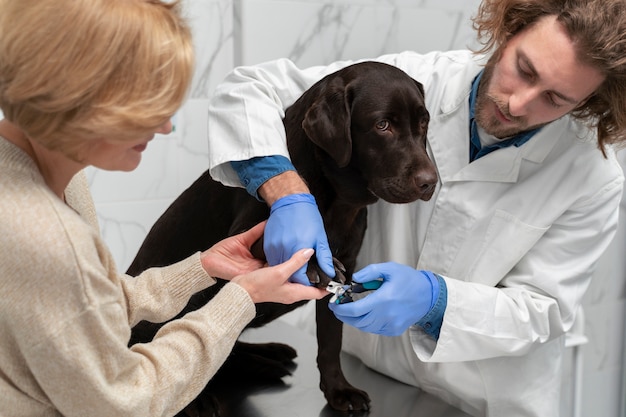Desert Dog Walks: Safe Exercise Tips for Hot Weather
Desert Dog Walks: Safe Exercise Tips for Hot Weather
When the summer sun blazes over Cathedral City and its surrounding communities, dog owners face a unique challenge: how to keep their four-legged friends active and healthy without risking heat-related issues. At Ridgeline Veterinary Clinic, we understand that keeping your dog moving is essential for their physical and mental well-being. However, the desert climate brings extreme temperatures and dry conditions that can quickly turn a simple walk into a potential health risk. In this guide, we’ll explore how to provide safe dog exercise in hot weather, the best times and places for activity, and hydration strategies to keep your pet comfortable during those toasty Cathedral City days.
We’ll cover how to recognize when the heat is too much for your dog, why hot weather is especially challenging in our region, and practical steps for summer pet safety in Cathedral City. You’ll also discover when it’s time to pause the walk and seek professional veterinary care. As your local "vet near me," Ridgeline Veterinary Clinic is here to support your pet’s health with preventive services and expert advice. For more insight into protecting your pet's paws during summer outings, you can also read our detailed summer paw protection tips to keep your pet comfortable and safe on walks during Cathedral City summers, including preventive care strategies.
Recognizing When the Heat Is Too Much: Signs Your Dog Needs a Break
Understanding your dog’s limits during the hottest months is crucial. Heat exhaustion and heatstroke are serious risks for dogs exercising in hot weather, especially in a desert climate where shade is limited and surfaces can become dangerously hot. Key symptoms of heat stress include excessive panting, drooling, and rapid breathing; you may also notice that your dog seems unusually sluggish, seeks out cool surfaces, or is reluctant to continue walking. Additional warning signs are reddened gums, vomiting, diarrhea, and collapse.
Some breeds are more vulnerable than others. Flat-faced breeds such as Bulldogs and Pugs, senior dogs, puppies, and pets with chronic medical conditions are particularly at risk for overheating. If your dog starts lagging behind, refuses to walk, or looks distressed, it’s time to stop immediately and find shade. The appearance of glazed eyes, unsteady walking, or confusion are signs to seek veterinary help right away, as these may indicate the onset of heatstroke.
Why Hot Weather Is Challenging for Dogs in Cathedral City
Cathedral City’s summer temperatures often soar well above 100 degrees Fahrenheit, and the dry climate means that moisture evaporates quickly. Dogs cool themselves primarily by panting, which is less effective in hot, dry air. Surfaces such as asphalt and concrete can reach temperatures hot enough to burn your dog’s paws within minutes, making midday walks especially hazardous.
Humidity is typically low in the desert, which can lead to rapid dehydration. Dogs may not realize how much water they’re losing as they pant, so it’s easy for them to become dehydrated before you notice any obvious signs. The risk of overheating increases dramatically when exercise is combined with direct sun exposure and inadequate hydration. For more comprehensive information on keeping your pet healthy during warm weather, scheduling a wellness examination is a great way to ensure your dog is prepared for summer activity in Cathedral City.
Safe Exercise Strategies: Timing, Surfaces, and Hydration
The key to safe dog exercise in hot weather is planning. The best times for walking your dog are early in the morning or later in the evening when temperatures are cooler and surfaces have had a chance to cool off. Midday walks should be avoided during the summer months, as this is when heat and sun exposure are most intense.
Choosing the right surface for your dog’s paws can make a big difference. Grass, dirt trails, or shaded sidewalks are gentler options than asphalt, which absorbs and retains heat. A simple test is to place the back of your hand on the pavement; if it’s too hot for your hand after a few seconds, it’s too hot for your dog’s paws. Paw burns are a real risk during summer pet safety efforts in Cathedral City, so always check surfaces before heading out.
Hydration is just as important as timing and surfaces. Always carry fresh, cool water for your dog, and offer it frequently during walks. Portable water bottles and collapsible bowls are convenient options for on-the-go hydration. Watch for signs of thirst such as excessive panting, licking lips, or a dry nose. Encourage your dog to drink before, during, and after exercise. Remember, smaller and older dogs may need more frequent water breaks.
If your dog enjoys vigorous exercise, such as running or playing fetch, consider moving these activities indoors or to a shaded dog park during the hottest months. Swimming can also be a safe and fun alternative for dogs who love water, provided you supervise them at all times.
Preventing Heat-Related Problems: Actionable Steps for Pet Owners
Preventing heat illness in your dog starts with preparation. Before heading out, check the temperature and humidity, and consider whether it’s safe for your dog’s breed, age, and health status. Key steps include walking during the coolest parts of the day, sticking to shaded or grassy routes, and keeping walks shorter when temperatures rise.
Apply pet-safe paw balm to help protect your dog’s feet from hot surfaces, and wipe their paws after walks to remove irritants and check for burns. Bring water for both you and your dog, and provide frequent rest breaks in the shade. For dogs with thick coats, routine grooming can help them stay cooler by removing excess hair and reducing matting.
Never leave your dog in a parked car, even for a few minutes, as temperatures inside vehicles can rise rapidly and become life-threatening. Be mindful of your dog’s unique needs; older pets, puppies, and brachycephalic breeds may require even shorter walks and closer monitoring. If you’re unsure about your dog’s fitness for summer exercise, scheduling a wellness examination with our veterinary professionals can provide peace of mind and personalized recommendations for pet exercise in Cathedral City.
When to Seek Veterinary Care: Knowing When It’s Time to Call for Help
Despite your best efforts, heat-related emergencies can still occur. If your dog shows signs of severe heat stress such as excessive panting, collapse, vomiting, diarrhea, or unresponsiveness, seek veterinary care immediately. Move your dog to a shaded, cool area, offer small amounts of water, and contact your local veterinary team as soon as possible.
In less severe cases, if your dog’s symptoms subside quickly after cooling down and resting, monitor them closely. However, any ongoing weakness, breathing difficulties, or confusion require prompt medical attention. Our team of veterinarians at Ridgeline Veterinary Clinic in Cathedral City, CA is here to provide comprehensive care for your pet, including diagnostic services and treatment for heat-related illnesses.
If you have questions about your dog’s ability to exercise in hot weather or want advice on summer pet safety in Cathedral City, don’t hesitate to reach out to us. We’re committed to helping you keep your pet healthy and active, no matter how high the temperatures climb.
Keeping Desert Dogs Safe: Your Local Partner for Year-Round Pet Wellness
Staying active is vital for your dog’s health, but in Cathedral City’s extreme summer climate, it’s essential to take extra precautions. Watch for signs of heat stress, walk during cooler times, choose safe surfaces, and prioritize hydration to ensure your dog can enjoy exercise without risk. Remember, every dog is different, and some may need more careful monitoring or adjustments to their routine.
Our veterinary team at Ridgeline Veterinary Clinic is dedicated to supporting your pet’s wellbeing with preventive care and professional advice tailored to the challenges of the desert environment. If you’re searching for a "vet near me" committed to quality veterinary services and summer pet safety in Cathedral City, our compassionate team is ready to help.
To schedule an appointment or ask about the best strategies for dog exercise in hot weather, call us at (760) 507-1500 or visit our Cathedral City location. For more expert tips on keeping your dog safe this summer, check out our summer paw protection tips to keep your pet comfortable and safe on walks during Cathedral City summers, including preventive care strategies or schedule a wellness examination to ensure your pet is ready for fun in the sun. Your dog's health is our top priority—let us be your trusted partner for all your veterinary needs in Cathedral City and surrounding communities.
This blog is intended for informational purposes only and should not replace professional veterinary advice. If you have concerns about your pet’s health or behavior, please contact your veterinarian directly.




















